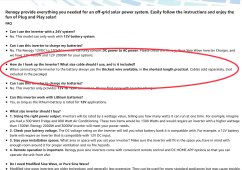Smiley2020
New Member
- Joined
- Sep 7, 2020
- Messages
- 14
Setting https://www.renogy.com/3000w-12v-pure-sine-wave-inverter/ up for the first time, wondering what is the optimum size wire for my needs. The manual has been no of help, in fact i feel gaslit and and at times disempowered reading it.
they assume you know the recommended wire gauge, does it depend on the fuse recommendations?

Plan to use this in an off grid homestead modular portable situation. At first either hooked up to two 100ah lifpoe4 or one 200ah battery (haven’t decided) it will be used to occasionally power a 8000btu AC and regularly power 500 and 1000 watt dehumidifiers on intermittent timers. It can be placed on a table within a foot of the battery bank. What wire where? i will buy a crimper kit and don’t care if it’s ready made, i want the best performance with the least stress on the inverter and batteries if i do want to push this thing hard. Fat fuses and fat wire best for my needs and possible future needs?
Amazon q&a mentions going fat and short

Will’s recommendation for 2-4k 12v inverters is a 9” 4awg pure copper cable, will this suffice or should i go fatter and shorter if i can?
I can go on and on about this Renogy user manual but the self righteous rage is too much, in the end i must laugh at them and me feeling bothered by english as a 10th language. Do they give themselves as an out honoring their warranty if the customer used the wrong wire?
they assume you know the recommended wire gauge, does it depend on the fuse recommendations?

Plan to use this in an off grid homestead modular portable situation. At first either hooked up to two 100ah lifpoe4 or one 200ah battery (haven’t decided) it will be used to occasionally power a 8000btu AC and regularly power 500 and 1000 watt dehumidifiers on intermittent timers. It can be placed on a table within a foot of the battery bank. What wire where? i will buy a crimper kit and don’t care if it’s ready made, i want the best performance with the least stress on the inverter and batteries if i do want to push this thing hard. Fat fuses and fat wire best for my needs and possible future needs?
Amazon q&a mentions going fat and short

Will’s recommendation for 2-4k 12v inverters is a 9” 4awg pure copper cable, will this suffice or should i go fatter and shorter if i can?
I can go on and on about this Renogy user manual but the self righteous rage is too much, in the end i must laugh at them and me feeling bothered by english as a 10th language. Do they give themselves as an out honoring their warranty if the customer used the wrong wire?




